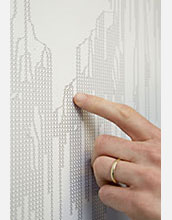All Images
News Release 08-081
How Did That Chain Letter Get To My Inbox?
New research shows the surprising paths taken by forwarded messages through the Internet
This material is available primarily for archival purposes. Telephone numbers or other contact information may be out of date; please see current contact information at media contacts.

Jon Kleinberg of Cornell University and David Liben-Nowell of Carleton College used a tree diagram to analyze the paths that forwarded e-mail petitions took through the Internet and into people's inboxes. The diagram allowed them to see how the messages got to people, and how many steps it took to get to them.
Credit: Jason Koski/Cornell University Photography
Download the high-resolution JPG version of the image. (44 KB)
Use your mouse to right-click (Mac users may need to Ctrl-click) the link above and choose the option that will save the file or target to your computer.
How do forwarded e-mail messages like chain letters and petitions get to so many people and into our e-mail inboxes? Jon Kleinberg, a professor of computer science at Cornell University, discusses his research into this phenomenon and the surprising results he and his colleague, David Liben-Nowell of Carleton College, discovered.
Credit: NSF, Cornell University

Jon Kleinberg of Cornell University in front of the tree diagram that illustrates how a single e-mail message can travel to thousands of user's inboxes.
Credit: Jason Koski/Cornell University Photography
Download the high-resolution JPG version of the image. (65 KB)
Use your mouse to right-click (Mac users may need to Ctrl-click) the link above and choose the option that will save the file or target to your computer.
